 This Second Look is going to be a bit shorter than normal. That’s because I’ve already reviewed Storyline: Fairy Tales and Storyline: Scary Tales is the same game, just with a spooky theme. Scary Tales comes with 30 new narrator cards, 100 new story cards, and 21 spooky tokens. Just like the original the box contains two storylines.
This Second Look is going to be a bit shorter than normal. That’s because I’ve already reviewed Storyline: Fairy Tales and Storyline: Scary Tales is the same game, just with a spooky theme. Scary Tales comes with 30 new narrator cards, 100 new story cards, and 21 spooky tokens. Just like the original the box contains two storylines.
“It was a dark and [Feature] night.”
So the first story begins.
I’m actually a bigger fan of Scary Tales than I was of Fairy Tales. The gloomy setting and spooky art are right up my alley. There’s nothing overly scary here, it is a family game after all, but there’s plenty of haunted manors, vampires, horsemen, curses, and slimy cards to satisfy the Halloween season. The new token set, shaped like coffins, contain icons like gravestones, a witch’s hat, and skulls.
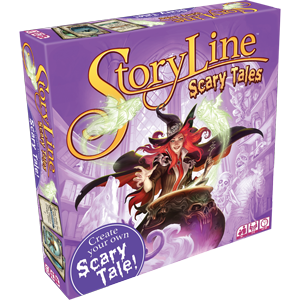 Scary Tales can also be combined with Fairy Tales to create even more fantastic stories, and it really works well. We’ve actually had a great time using narrator cards from one game with the story cards from another. Mixing them all together is really the best way to play, though
Scary Tales can also be combined with Fairy Tales to create even more fantastic stories, and it really works well. We’ve actually had a great time using narrator cards from one game with the story cards from another. Mixing them all together is really the best way to play, though
Storyline: Scary Tales is available now, and I highly recommend picking it up. Pick both Storyline games up. They’re perfect for family game night and work well down to around age 5 or 6. If you’re only going to pick up one, Scary Tales would be my first choice.
A copy of Storyline: Scary Tales was provided free for review by Asmodee.
- Comments Off on Second Look—Storyline: Scary Tales
Second Look—Kill Doctor Lucky 19.5 Anniversary Edition
24 Sep
Posted by Rob Kalajian as Classic Board Games, Modern Board Games
 People have been trying to kill Doctor Lucky for 20 years now, so what better way to celebrate than with Cheapass Games’ Kill Doctor Lucky 19.5 Anniversary Edition. The game has been out of print since 2006, so I’m sure people are going to be happy it’s back on the market. It’s packed full of all the Lucky killing action that players have come to know and love and adds just a bit more polish to the game.
People have been trying to kill Doctor Lucky for 20 years now, so what better way to celebrate than with Cheapass Games’ Kill Doctor Lucky 19.5 Anniversary Edition. The game has been out of print since 2006, so I’m sure people are going to be happy it’s back on the market. It’s packed full of all the Lucky killing action that players have come to know and love and adds just a bit more polish to the game.
Now I have to admit that I’ve never actually played Kill Doctor Lucky before this, so I can’t compare editions. What I can do is tell you how much I enjoyed the game with two of my boys. Killing Doctor Lucky, as it turns out, is a pretty fun thing to do. All the flavor text on the character cards, weapons cards, and pretty much anywhere else they can fit flavor text, it hilarious to read. That, and ruining someone’s chance to kill the good doctor both bring a very satisfying element to the game.
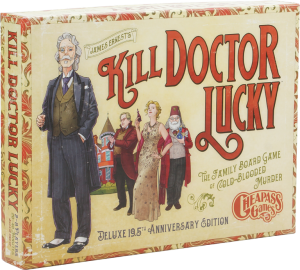 I should mention there’s a bunch of variations of the game included in the box, but so far we’ve just played the standard version where you’re trying to kill the old man. In one variation there’s a cat that is placed on the board and moved instead of your player pawn. If the cat is in a room with any player, they can’t see out of that room. There’s also rules for a variation of the game where Doctor Lucky comes back as a ghost and tries to kill all the players.
I should mention there’s a bunch of variations of the game included in the box, but so far we’ve just played the standard version where you’re trying to kill the old man. In one variation there’s a cat that is placed on the board and moved instead of your player pawn. If the cat is in a room with any player, they can’t see out of that room. There’s also rules for a variation of the game where Doctor Lucky comes back as a ghost and tries to kill all the players.
I really can’t believe I’ve never played this game before today. It’s a fun and humorous game with simple rules, a bit of bluffing, and a lot of attempted murder. The 19.5 Anniversary Edition is available now for $40, which is about $10 too high in my opinion. Nevertheless, this feels like one of those games that should be in every gamer’s collection.
A copy of Kill Doctor Lucky 19.5 Anniversary Edition was provided free for review by Cheapass Games.
- Comments Off on Second Look—Kill Doctor Lucky 19.5 Anniversary Edition
 When I reviewed Princes of the Apocalypse, I commented that the first half of the book “can almost be used as just a setting book for the Dessarin Valley”. But that didn’t prepare me for what I’d find when opening up Storm King’s Thunder: over a fifth of this 256-page book is devoted to quick looks at an area that makes up the Dessarin Valley, and areas north of Mirabar, south past Daggerford, and as far east as Anauroch. Those “quick looks” are anywhere from a paragraph of few lines to a full page, several with suggested encounters (most centered around the giant activities that drive this book’s campaign). In the section before that, two major locations in the Dessarin Valley are detailed (and one location far to the north). Combine this with Princes of the Apocalypse, and you’ve got a fantastic gazetteer for your campaign. A section of Mike Schley’s Forgotten Realms map is used in that 50+ page setting section.
When I reviewed Princes of the Apocalypse, I commented that the first half of the book “can almost be used as just a setting book for the Dessarin Valley”. But that didn’t prepare me for what I’d find when opening up Storm King’s Thunder: over a fifth of this 256-page book is devoted to quick looks at an area that makes up the Dessarin Valley, and areas north of Mirabar, south past Daggerford, and as far east as Anauroch. Those “quick looks” are anywhere from a paragraph of few lines to a full page, several with suggested encounters (most centered around the giant activities that drive this book’s campaign). In the section before that, two major locations in the Dessarin Valley are detailed (and one location far to the north). Combine this with Princes of the Apocalypse, and you’ve got a fantastic gazetteer for your campaign. A section of Mike Schley’s Forgotten Realms map is used in that 50+ page setting section.
Your players will be at one of the three locations very early in the campaign, defending the location from attack. However, you’re not just playing your heroes, each player at the table is given an NPC they’re in control of. While the battle rages on, your heroes and these others aren’t necessarily in the same location. The NPC survives? They’ve got some storylines your players can follow up on, things that require your heroes to travel quite some distance to complete – one has your heroes escorting the character to the next town over to meet their boss who then tasks them to safeguard a wagon to a town way the heck far away after which they get an anonymous bundle that directs them to a town even further away in the opposite direction where they’ll get their final reward which is pretty cool indeed.
Storm King’s Thunder seems to have a lot of travelling involved.
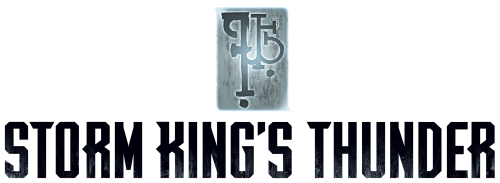
It feels natural to compare Storm King’s Thunder to Princes of the Apocalypse. Both take place in the same general area (although this giant adventure can take heroes far afield from the valley). Both have a preferred story progression while including some free-form events. Both have a large section dedicated to the overall setting, tempting the Dungeon Master to make it her own. However, while Princes is set up assuming the heroes would tackle the elemental cults and temples in a level-appropriate manner, there’s nothing stopping a group of 4th level heroes from stumbling into an area designed for 7th level adventurers, complete with a staircase leading down to a place for 10th level heroes, Storm King’s Thunder has an adventure flowchart designed to avoid just that issue. This isn’t to say there’s a lack of choices for the players.
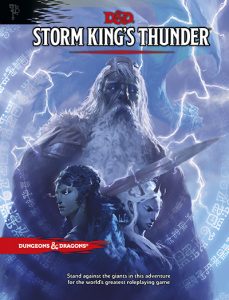 The adventure proper begins with a choice of the three locations mentioned earlier. If your heroes head to the major location far to the north, they don’t have the adventuring goodness that’s at the two different major locations in the Dessarin Valley. Likewise, the middle part of the campaign offers to take the heroes to multiple locations, but they only need to go to one to progress to the conclusion. This final act has some branching options as well. In other words, my group playing Storm King’s Thunder will most likely have a wildly different story to tell than your group playing the same campaign.
The adventure proper begins with a choice of the three locations mentioned earlier. If your heroes head to the major location far to the north, they don’t have the adventuring goodness that’s at the two different major locations in the Dessarin Valley. Likewise, the middle part of the campaign offers to take the heroes to multiple locations, but they only need to go to one to progress to the conclusion. This final act has some branching options as well. In other words, my group playing Storm King’s Thunder will most likely have a wildly different story to tell than your group playing the same campaign.
Storm King’s Thunder forgoes standard XP and leveling, opting to reward the players by completing goals. Each section of the book has a character advancement sidebar, giving direction for when the heroes gain levels. Thus, that middle part of the campaign where the players have multiple paths but only need one to advance the storyline, they all hit 9th level when completing that mission. Less bookkeeping, more adventure, if you ask me.
The cartography is all over the place within this product. However, unlike earlier storyline campaign books, none of the maps are signed, so it’s difficult to tell who did what. You’ve got some things that look more like general fantasy maps instead of something worthy of the word “cartography”. You’ve got small maps that incorporate hand-drawn imagery to stuff that looks like it’s built using basic shapes in Illustrator or thrown together using different terrain packages in Roll20. Then you’ve got the map of Triboar, which looks completely hand-drawn. There are six different cartographers listed in the credits, all with differing styles. This probably won’t bother you, but in my day job as a graphic artist working with book layouts similar to this, it bugs the heck out of me.
The artwork, also with some varying styles, is much more in sync. Those NPCs your heroes could control? There’s eighteen of them with a large range of body sizes, skin color, and ethnicity (if you translate all the fantasy races over to “human”). The collage of images on the cover is impressive – you can see the standalone King Hekaton on the first page of the book and the combined illustration collage before graphic elements were added to it on the second page.
Several tie-ins to this storyline are available and planned, including an Assault of the Giants boardgame from WizKids, Roll20 and Fantasy Grounds ready-made adventures, and more.
A copy of Storm King’s Thunder was provided free for review by Wizards of the Coast.
- Comments Off on Second Look – Storm King’s Thunder
Second Look—Magic: The Gathering – Arena of the Planeswalkers: Shadows Over Innistrad
17 Aug
Posted by Rob Kalajian as Miniatures
 Shadows Over Innistrad is the latest set in Magic’s Arena of the Planeswalker line. It’s a full, base set, so you don’t need the first set to play like you did with Battle for Zendikar. Since I’ve already reviewed Arena of the Planeswalkers, I’ll cut to the chase with this new set.
Shadows Over Innistrad is the latest set in Magic’s Arena of the Planeswalker line. It’s a full, base set, so you don’t need the first set to play like you did with Battle for Zendikar. Since I’ve already reviewed Arena of the Planeswalkers, I’ll cut to the chase with this new set.
If you were to only buy one Arena of the Planeswalker products, Shadows Over Innistrad would be the one to get. The box is packed full of great stuff, and even though you only get 4 Planeswalkers (the fifth figure is the werewolf form of another) you get more bang for your buck than with the original base set.
For starters, three of the four Planeswalkers are multicolored: Sorin (black/white), Nahiri (red/white), and Arlinn (red/green). You also get more miniatures overall in the box, including new Hero units. These are basically an in-between. More powerful than regular minions, but not as powerful as Planeswalkers. The Cryptoliths (plastic tree-like things) can be destroyed, unlike terrain in the original set.
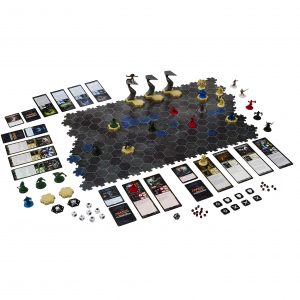 Overall Shadows Over Innistrad comes across as more polished that the original base set. It’s also the same price, $30.
Overall Shadows Over Innistrad comes across as more polished that the original base set. It’s also the same price, $30.
So like I said earlier: if you were to only to get one Arena of the Planeswalkers sets, this is the one to get. Realistically? Get one of each. Having all the extra figures, spells, and Planeswalkers only makes the game that much better. While the release schedule of items isn’t as aggressive as Heroscape’s was, that may be the saving grace in the end of Arena of the Planeswalkers. It would be really nice to see them do a base set, small expansion, then repeat the pattern each year.
A copy of Magic: The Gathering – Arena of the Planeswalkers: Shadows Over Innistrad was provided free for review by Hasbro.
- Comments Off on Second Look—Magic: The Gathering – Arena of the Planeswalkers: Shadows Over Innistrad
 ZIPANG -Portable- is a quick little card game by Engine ID that’ll be hitting Kickstarter soon. It’s a precursor to a larger board game currently being developed by the company. It’s actually available now via The Game Crafter for those who want an early look at the game, similar to the experience I had with it.
ZIPANG -Portable- is a quick little card game by Engine ID that’ll be hitting Kickstarter soon. It’s a precursor to a larger board game currently being developed by the company. It’s actually available now via The Game Crafter for those who want an early look at the game, similar to the experience I had with it.
ZIPANG plays a bit like Love Letter. There’s only a few cards, each of which has a special power. Unlike Love Letter, you can attack your fellow players to knock them out of a round. Of course there’s ways for them to defend themselves. The goal in the end is to have the most Mangoku Coins at the end of the game, which ends when one player is completely out of the coins.
 You can see the full rules of the game here. These are the latest rules sent to me by the designer, but they are still a work in progress.
You can see the full rules of the game here. These are the latest rules sent to me by the designer, but they are still a work in progress.
Gameplay is clever, the artwork is colorful and enthralling. There’s plenty of great card combos here, and lots of tough choices to make during play. Do you attack with a high powered card, or save that card in your hand to work as your defense? Do you play a great special power, or keep that card because it’s high Honor value might win you the round if the Emperor is played?
You can snag the early-release version of ZIPANG from The Game Crafter for $24. If you want to wait for the Kickstarter, a pledge of $19 will get you a copy of the game if the project is funded. If you want to go the print-and-play route there will also be a $5 pledge-level for that.
The kids and I really enjoyed this one. It’s quick, easy to learn, and has enough strategy to keep us coming back from more. I initially didn’t know what to expect from this one, and was pleasantly surprised with how good it really is.
A copy of ZIPANG -Portable- was provided free for review by Engine ID.
- Comments Off on Second Look—ZIPANG -Portable-
 Hanna Honeybee is part of HABA’s My Very First Games line, a line aimed at kids 2+ years old. Having a 2-year-old in the house, I jumped at the opportunity to give the game a try. The game is very simple, with colorful components and a great little gimmick that had my little guy squealing with delight.
Hanna Honeybee is part of HABA’s My Very First Games line, a line aimed at kids 2+ years old. Having a 2-year-old in the house, I jumped at the opportunity to give the game a try. The game is very simple, with colorful components and a great little gimmick that had my little guy squealing with delight.
Let’s start with that. Hanna Honeybee’s box is also an important part of the game. There’s a cardboard insert that fits into the box with a slot on the top and a ramp on the bottom. In each game flower tiles are inserted in the top slot and flipped over to their honey side before being sent out the bottom. Every time we play my son exclaims “Honey!” whenever a tile comes sliding out. Laughter follows for a while and we can continue play.
There’s two ways to play Hanna Honeybee. The first involves rolling a die and moving the wooden Hanna token over to a flower of that color. Then the tile is inserted into the box and the honey that comes out is placed in the honey pot. Players work together to fill the honey pot with 6 honey tiles. Be careful, though! If you roll a wilted flower then one of the flowers is removed from the game. The goal here is color recognition, taking turns, and following mutli-step directions.
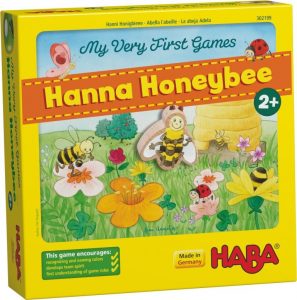 The second way to play adds a little memory into the game. All the flower tiles are flipped to the honey side, and the players must try and find the color flower that they rolled. Didn’t find the right color? That’s OK! You can take another turn if you can successfully name the color of the flower you did turn over. Once you find the right color Hanna can take the flower, turn it into honey, and place it in the honey pot. Once again, 6 honey tiles in the honey pot wins the game, and a wilted flower roll removes a tile.
The second way to play adds a little memory into the game. All the flower tiles are flipped to the honey side, and the players must try and find the color flower that they rolled. Didn’t find the right color? That’s OK! You can take another turn if you can successfully name the color of the flower you did turn over. Once you find the right color Hanna can take the flower, turn it into honey, and place it in the honey pot. Once again, 6 honey tiles in the honey pot wins the game, and a wilted flower roll removes a tile.
Like I said before, the games are very simple. However, they’re great for a 2-year-old. My toddler asks to play all the time, and always multiple times in a row. He loves moving Hanna to the flowers, and loves placing them in the hive to be flipped even more.
You can snag Hanna Honeybee for $27.99 from HABA’s site. I highly recommend you do if you’ve got children in the age range. I know we’re happy with the game, and will be gifting copies to family members this holiday season.
A copy of Hanna Honeybee was provided free for review by HABA.
- Comments Off on Second Look—Hanna Honeybee
 Mystic Vale, a game I’ve been eagerly awaiting since I first saw the initial thoughts on the system during Toy Fair 2015, is AEG’s new deck building game. The gimmick here? AEG’s Card Crafting System. Instead of buying cards each turn, you’re buying advancements that can be sleeved into your base cards. Through various card combinations you’ll get more mana to spend, icons to purchase Vale Cards that give you even more power, and victory points. VP can either be active, earned every time the card is drawn, or inactive, awarded at the end of the game. The game ends when the VP pool is emptied, then all VP are calculated. Highest VP wins the game. The video below lays out everything fairly well:
Mystic Vale, a game I’ve been eagerly awaiting since I first saw the initial thoughts on the system during Toy Fair 2015, is AEG’s new deck building game. The gimmick here? AEG’s Card Crafting System. Instead of buying cards each turn, you’re buying advancements that can be sleeved into your base cards. Through various card combinations you’ll get more mana to spend, icons to purchase Vale Cards that give you even more power, and victory points. VP can either be active, earned every time the card is drawn, or inactive, awarded at the end of the game. The game ends when the VP pool is emptied, then all VP are calculated. Highest VP wins the game. The video below lays out everything fairly well:
How does it play? I’ve played with my kids, and we all really enjoyed it. My 6-year-old really took to the game well, and pulled a win during our first game! The push-your-luck element initially seemed to be a pain, but with clever card crafting really comes into it’s own and can be a powerful tool to getting many cards out on the table. The card crafting system has some cool combos that can be made, and feels like it can really be expanded on in the future.
My only real complaints are that the game takes a bit to ramp up. Initial turns seem a bit slow and unproductive only to have the pace of the game rapidly increase for a shorter endgame once you’ve crafted some powerful cards. There’s also no real player interaction. It’s very much a solo game of trying to ramp up and empty the VP pool.
Mystic Vale is a fun deck builder, and the card crafting mechanic is pretty cool. Ramp up is a bit slow, but that’s something that could probably be fixed by seeding some already crafted cards into the base decks. I highly recommend playing it first before purchase, if possible. It may not be for everyone, but I can tell it’s a game that’ll get a lot of play in my house.
A copy of Mystic Vale was provided free for review by AEG.
- Comments Off on Second Look—Mystic Vale
 “Who are we? Where are We from?”
“Who are we? Where are We from?”
I first saw Aurora at CT FIG 2016 while playing Elements at the Rampage Games booth. Not having time to play that day, Rampage sent me a copy of my own to checkout. I finally had a chance to sit down and play with my kids, and was surprised what a competent little set collection game it is.
Aurora is a game about creating star systems that can support sentient life. It was a submission to The Game Crafter’s Learning Game Challenge, and made it to the finals.
Each round you’re creating or expanding star systems trying to meet all the requirements for intelligence. Every card in your star system also provides a certain amount of either Water, Carbon, or Oxygen. Building your levels of these resources earn you bonuses throughout the game. There’s also event cards that can be played to help yourself or hinder other players. Once a round is over you can save up to three cards, pass the rest to the player on the left, then draw up to 6 cards for a max hand size of 8. Play continues until either one person develops intelligence, has life in three star systems, or maxes out their resource tracks. It plays in about 30 minutes, and the kids and I had a blast while playing.
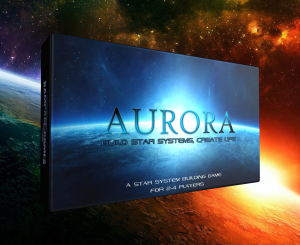 There are a few pitfalls, though. The rules aren’t as clear as they could be, and make the game seem a bit more complicated than it really is. Also, the colors on some of the components, especially the reference guide and rule book, blend a bit and make the text hard to read in some areas. Overall these aren’t really deal breakers, but are items that can be fixed to make Aurora a much more solid package.
There are a few pitfalls, though. The rules aren’t as clear as they could be, and make the game seem a bit more complicated than it really is. Also, the colors on some of the components, especially the reference guide and rule book, blend a bit and make the text hard to read in some areas. Overall these aren’t really deal breakers, but are items that can be fixed to make Aurora a much more solid package.
Aurora packs a lot of game into a deck of cards. Between the multiple paths to victory and drafting mechanics, it provides a good amount of depth is a short period of time. It’s also easy enough to play with kids. My 6-year-old was able to grasp the game well enough to play on his own after a few rounds, and my 9-year-old pulled out a surprise victory by developing intelligence on our first play of the game.
A copy of Aurora was provided free for review by Rampage Games.
- Comments Off on Second Look—Aurora
 Grimslingers may come in a small box, but there’s a lot of game packed in there. Not packed well, but packed all the same.
Grimslingers may come in a small box, but there’s a lot of game packed in there. Not packed well, but packed all the same.
Inside said box is two games. A dueling game, and a cooperative adventure. Both share some cards, but there’s also cards that are pretty much used in one or the other. Everything is kind of just tossed into the box when you’re done, so you’re doing to have to find your own solution for keeping things organized.
Does that in any way, shape, or form diminish the game? No. Not at all.
In Grimslingers, the rules have you starting off with a simple duel. No extra cards, no fancy rules You choose your character, anima, and get a hand of spell cards. The character and anima you choose are just polish, as there’s no player powers or the like. At that point it’s setup your turn, play a spell, resolve for damage. Certain spells trump other ones, but there’s a deck of numbered cards to use if neither spell trumps the other. Then it’s taking turns drawing these cards trying to get as close to 11 as possible without going over. The person that does has their spell resolve.
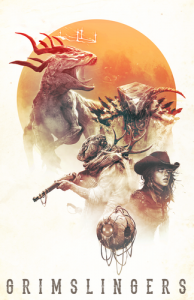 Duels then get a bit more complicated from there as you add in the advanced rules, and more cards. All of this is really just to prepare you for the co-op adventure mode which has it’s own story book for playing through various scenarios. Does it all pull together in the end?
Duels then get a bit more complicated from there as you add in the advanced rules, and more cards. All of this is really just to prepare you for the co-op adventure mode which has it’s own story book for playing through various scenarios. Does it all pull together in the end?
Yes. An overwhelming yes.
While there’s a lot to take in, the game plays wonderfully, and drips with theme. The duels are great for a quick play, but the game really shines in co-op. The game sessions are longer, but there’s monsters to beat, treasure to take, and you can level your character over the course of play. It’s pushing into RPG territory at that point.
While it may be a bit harder to get this to the table with my kids, it’s one that I’m going to make sure I make time to sit down and play. There’s a story to finish, and I want to finish it!
Grimslingers is currently available for pre-order for $29.95, and will ship September 1st. You can also buy just the Duels version for $9.95. While it’s nice that you can buy the stripped down version, the full deal is the way to go.
A copy of Grimslingers was provided free for review by Greenbrier Games.
- Comments Off on Second Look—Grimslingers
 This must be the week for dragons, because here comes a look at Blue Orange Games’ Dragon Run. I’ve actually had this one for a while, and now seemed the perfect time to post about it.
This must be the week for dragons, because here comes a look at Blue Orange Games’ Dragon Run. I’ve actually had this one for a while, and now seemed the perfect time to post about it.
Designed by Bruno Cathala, Dragon Run is a push-your-luck game of escaping a dragons cave with the most treasure…and without dying. Each turn players can charge blindly into the dragons lair, sneak carefully in, or cry like a baby. Charging lets you grab the most loot. Sneaking gets you some, and calms the dragon a bit, and crying like a baby give you a pass, but you lose some loot.
Of course just running in and grabbing look would be too easy, right? Some cards give you treasure. Some let you keep drawing. One is the dragon’s fiery breath. Get that and lose one of your two hit points. Die and you’re out of the game. Have the most treasure when the dragon loses interest in everyone and you win the game!
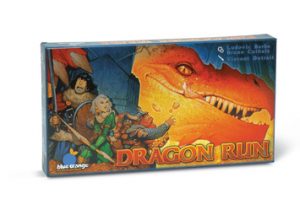 Of course there’s more to it than that, but not much. Each character has a special ability that’ll help them out in the quest for loot. Also, while there’s nothing like watching other people get toasted, if everyone dies then the dragon wins. So it’s not always in your best interest to leave the other players without a little support.
Of course there’s more to it than that, but not much. Each character has a special ability that’ll help them out in the quest for loot. Also, while there’s nothing like watching other people get toasted, if everyone dies then the dragon wins. So it’s not always in your best interest to leave the other players without a little support.
Dragon Run is light, fast, and a really fun time. While you’re not getting a ton of components for your $25, you’re getting a great game. I’m a big fan of Blue Orange, and this is one of the best I’ve played from them.
A copy of Dragon Run was provided for free for review by Blue Orange Games.
- Comments Off on Second Look—Dragon Run
Trending
- Are Board Games Dangerous?
- Home
- Sequence Game, and Variants
- The 20 Most Valuable Vintage Board Games
- Oh the Irony—Illuminati Card Game Continues to Inspire Conspiracy Theorists
- Newton's Apples, a Gravity Strategy Game
- Hasbro and Mattel Merger?
- Cheaters Caught Hacking Automatic Mahjong Table
- Cars 2 Games
- Richard III
Archives
Most Popular Articles
- The 20 Most Valuable Vintage Board Games
- Sequence Game, and Variants
- USPS Adds Board Game Flat Rate Box
- Baila, the Estonian Drinking Card Game
- The 13 Most Popular Dice Games
- The Truth About Dominoes On Sunday in Alabama
- Are Board Games Dangerous?
- Oh the Irony—Illuminati Card Game Continues to Inspire Conspiracy Theorists
- The Convoluted Story of Iron Wind Metals, Ral Partha, and Battletech Miniatures
- Guess Who? The Naked Version
Recent Posts
- Toy Fair 2019—Breaking Games
- Talisman Kingdom Hearts Edition
- Toy Fair 2019—Winning Moves
- Toy Fair 2019—Games Workshop
- Toy Fair 2019—Star Wars Lightsaber Academy
- Toy Fair 2019—Stranger Things Games
- Toy Fair 2019—HABA
- Licensing Roundup
- Game Bandit
- 2018 A Difficult Year For Hasbro But Not For D&D Or MtG
Recent Comments
- on Toy Fair 2019—Winning Moves
- on Game Bandit
- on Second Look—Dungeons & Dragons Waterdeep Dragon Heist
- on Crowdfunding Highlights
- on Beyblade SlingShock
- on Game Bandit
- on Game Bandit
- on Watch This Game!, the Board Game Review Board Game
- on Second Look—Vampire: The Masquerade 5th Edition
- on Palladium Books Loses Robotech IP License, Cancels Five-Year-Overdue Robotech RPG Tactics Kickstarter



